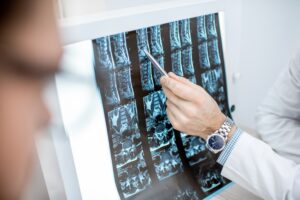Your thoracic spine is oftentimes the most overlooked section of your spine. Low back pain is more common due to the effects of prolonged sitting, while cervical spine pain tends to develop when we have poor head posture or are regularly looking down at our phones or hunched forward staring at a computer screen. Our thoracic spine or mid-back is inherently more protected than the upper and lower portions of our spine, but that certainly doesn’t mean that it is immune from injury or disc degeneration. In today’s blog, we take a closer look at why your thoracic spinal discs can break down and how we can help keep your middle back healthy.
Thoracic Spinal Disc Degeneration Causes And Symptoms
Although your middle spine is more protected than the cervical and lumbar areas, the middle portion of your spine still handles a fair amount of stress on a regular basis. This means that it is not immune from wear, tear and natural degeneration that can occur as a result of stress on the spine over the course of a number of years. Thoracic spinal degeneration can also occur more quickly if you suffer an injury to your mid-back, or if you have an underlying genetic predisposition. Lifestyle factors, like performing repetitive actions that stress your middle back at work, obesity and smoking can all increase your risk of thoracic spine degeneration.
Symptoms of thoracic disc degeneration include:
- Pain in the middle back
- Limited range of spinal motion
- Discomfort that moves to the arms, hips or legs
- Muscle weakness
- Numbness
- Shooting pain sensations if the disc is impinging a nearby nerve
Diagnosing And Treating Thoracic Back Pain
If you are dealing with discomfort in your middle spine or certain physical activities have become more difficult due to range of motion problems with your back, consider setting up an appointment with a spine specialist like Dr. Jackman. He’ll begin by reviewing your medical history, asking about your symptoms and taking a closer look at your spine. He may have you perform some simple movement tests to see how your back responds to these actions to get a better idea of what types of deficits you’re dealing with. To confirm a diagnosis or rule out a possible issue, he may order an imaging test in the form of an X-ray, MRI or CT scan.
If mid-back disc degeneration is confirmed, your doctor will walk you through some treatment techniques. Although there is no way to naturally restore disc height that has been lost due to degeneration, some simple lifestyle changes and non-operative treatment techniques can work to alleviate symptoms and help you remain active. While treatment will be determined on an individualized basis, oftentimes a combination of the following treatment techniques prove helpful at reducing or completely eliminating symptoms: Rest, posture improvements, weight loss, controlled stretching, regular exercise, physical therapy or a corticosteroid injection.
Non-operative techniques pursued over the course of a few weeks tend to provide relief, but if you’re still in pain or your condition has worsened, surgery may be an option. Disc replacement or a fusion procedure are the most common surgical treatments, and they each have their own unique benefits and drawbacks. Your surgeon can walk you through the specifics of each procedure should it become necessary, but most patients with mild or moderate thoracic disc degeneration will experience enough relief with conservative techniques that surgery is not considered.
Like all forms of back pain, thoracic spine pain typically gets worse unless proactively treated, so don’t delay treatment if you begin to notice pain or discomfort in your middle back. For more information on how these issues are typically treated, or to talk to a back specialist about a different issue you are dealing with, reach out to Dr. Jackman and the team at The Midwest Spine & Brain Institute today at (651) 430-3800.


 Cervical Radiculopathy – Causes, Symptoms And Treatment Options
Cervical Radiculopathy – Causes, Symptoms And Treatment Options